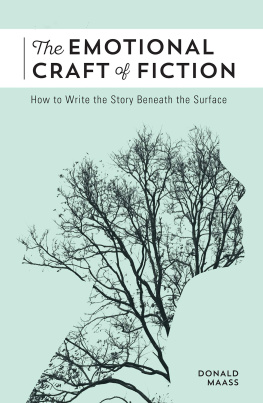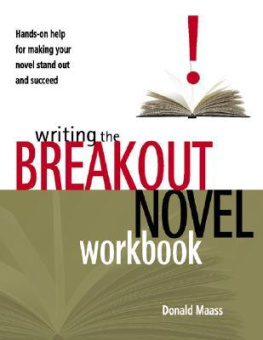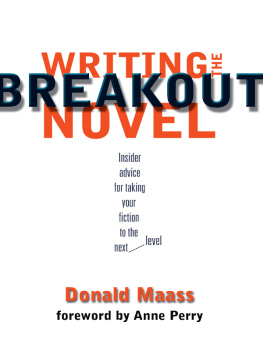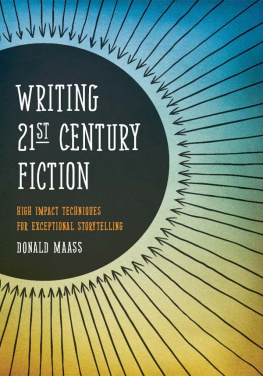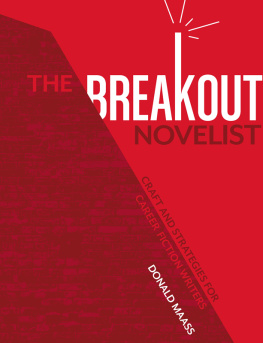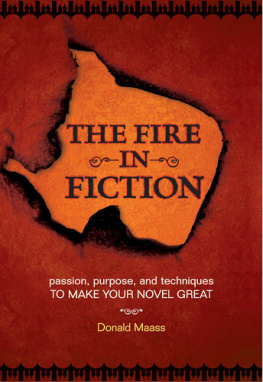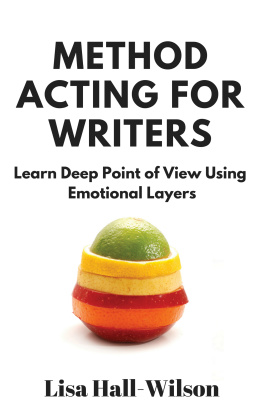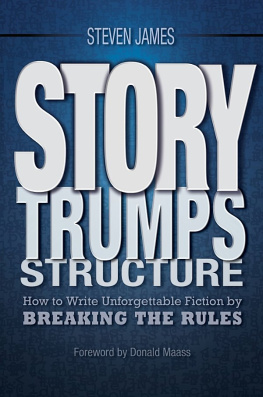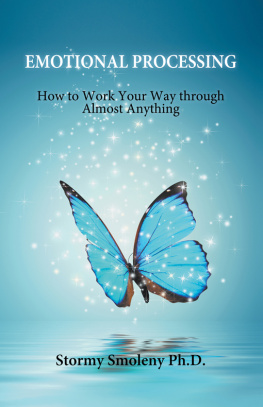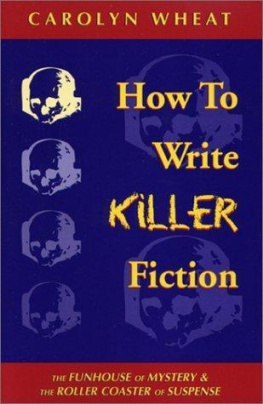Donald Maass founded the Donald Maass Literary Agency in New York in 1980. His agency sells more than 150 novels every year to major publishers in the U.S. and overseas. He is the author of The Career Novelist (1996), Writing the Breakout Novel (2001), Writing the Breakout Novel Workbook (2004), The Fire in Fiction (2009), The Breakout Novelist (2011), and Writing 21st Century Fiction (2012). He is a past president of the Association of Authors' Representatives, Inc.
Chapter 1
The Emotional Craft of Fiction
The world of fiction writers is a collection of opposites: factions at odds in their beliefs, values, purpose, and way of writing. Some authors have commercial intent; others, literary. Some outline; others explore story in successive drafts. For some, genre is a badge of pride; for others, its a hateful label. Prestige matters greatly to some, money to others, and movie options to a misguided few.
A dichotomy less often discussed is the division between those who are comfortable writing emotions and those who find putting emotions on the page repellent. The latter group values showing. To get a reader to feel what a character feels, the thinking goes, put the reader through a characters experience. Provoke emotions in readers; dont spoon-feed them feelings. Most valuable of all to this group is the capturing of moments. These are passages so honest, vivid, and true that they transcend mere words. Readers recognize the universal human condition.
For other writers, telling is a positive. They go inside the mind and heart of a character to observe and feel story events just as that character does. Writing out characters emotions is the essence of intimate storytelling. How else can you bring a character fully alive? For these authors, the highest expression of the art are passages of extended telling, in which a characters inward condition is captured in nuanced detail by means of words alone.
While few authors are purists of showing or telling, most lean more in one direction or the other. Even so, most agree that showing is better than telling, in general. And most blend the two. There isnt much debate of the topic. When it comes up at writers conferences, the issue is usually framed as a question: Whats the right balance between showing and telling?
Having researched, studied, and taught the handling of emotions in fiction, I have reached an altogether different conclusion. Fiction writers are asking the wrong question. Showing and telling are fine as far as they go, but the emotional experience of readers has little to do with that. The most useful question is not how can I get across what characters are going through? The better question is how can I get readers to go on emotional journeys of their own?
Showing and telling are only part of the picture. But, they are not even the most important part. As we will discover, readers may believe that theyre living a story along with its characters. Actually, theyre not. Readers are having their own experience that is merely occasioned by whats on the page.
That experience can be elicited, or not, by any number of story elements: plot, setting, theme, mood, dialogue, and, yes, what characters themselves feel. What the novelist is doing, though, is not causing readers to feel as the novelist does, or as his characters do, but rather inducing for each reader a unique emotional journey through a story.
When you think about it, this makes perfect sense. No two readers read a novel the same way. How could they possibly? To see how differently folks experience a work of fiction, check their comments on Goodreads. Are those people all reading the same novel?
The purpose of this book is to delve into the ways and means of creating a powerful emotional experience for readers as they read. Well look at effective ways of showing and telling, naturally, but theres much more to it than that. The dynamics of reader responses are complex. Equally complex and as varied in their effect are character arcs, journeys of self-discovery, which in turn cannot happen without ongoing emotional struggle.
The language of emotion in a novel also makes a difference to readers experiences. Plot, too, can be understood as a sequence of emotional milestones. As a writer, you are on an emotional journey as you write, as well, a journey that informs and influences not only the story you are creating, but also your voice and very identity as a writer.
Why is it important to look at fiction writing through the lens of emotional experience? Because thats the way readers read. They dont so much read as respond. They do not automatically adopt your outlook and outrage. They formulate their own. You are not the author of what readers feel, just the provocateur of those feelings. You may curate your characters experiences and put them on display, but the exhibits meaning is different in thousands of ways for thousands of different museum visitors, your readers.
Not every published novel creates a powerful emotional experience for readers. In the slush pile the conditions are even worse. Too many manuscripts provoke very little feeling at all. The sad truth is that television commercials can stir more feelings in thirty seconds than many manuscripts do in three hundred pages.
How many novels have moved you to tears, rage, and a resolution to live differently? How many have left a permanent mark, branding you with a story that you will never forget? The number probably isnt great, and of that small number I suspect most of your memorable choices are not current novels but classics. What makes them classics? Artful storytelling, sure, but beyond the storytelling, classics have enduring appeal mostly because we remember the experiences we had while reading them; we remember not the art but the impact.
When a plot resolves, readers are satisfied, but what they remember of a novel is what they felt while reading it. Hooks may hook, twists may intrigue, tension may turn pages, and prose may dazzle, but all of those effects fade as quickly as fireworks in a night sky. Ask readers what they best remember about novels and most will say the characters, but is that accurate? Its true that characters become real to us but that is because of what they cause us to feel. Characters arent actually real; only our own feelings are.
Emotional impact is not an extra. Its as fundamental to a novels purpose and structure as its plot. The emotional craft of fiction underlies the creation of character arcs, plot turns, beginnings, midpoints, endings, and strong scenes. It is the basis of voice.

